


These Hallowed Walls
 To
many, the Administration Building personifies Walla Walla College. In the
early days, you could have slept, eaten, and attended classes, chapel and
a parlor party, and also worked a job in the powerhouse, all under the roof
of the Ad Building.
To
many, the Administration Building personifies Walla Walla College. In the
early days, you could have slept, eaten, and attended classes, chapel and
a parlor party, and also worked a job in the powerhouse, all under the roof
of the Ad Building.
Today, hints of the building’s past lives remain. A single basin sink in a second floor classroom once soaked the brushes of art students taught by Lulu Hill-Miller. A fireplace in the Admissions and Marketing Office, once the domain of records director Orpha Osborne, originally warmed the South Hall women’s parlor. A glass-block window, shaped like a door, once opened to a passageway between the rear dorm wings named North and South Hall.
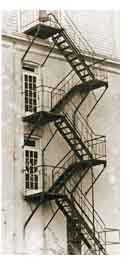 The
building’s oddities became quaint and charming, especially after you mastered
maneuvering the stairs and hallways. Many a freshman grew frustrated on his
or her first day of classes, attempting to solve the Byzantine mystery of
the location of rooms on the third floor. A visit to the bell tower reads
like a “Who’s Who” of WWC students and faculty, thanks to the time honored
tradition of visitors chalking their names on the walls.
The
building’s oddities became quaint and charming, especially after you mastered
maneuvering the stairs and hallways. Many a freshman grew frustrated on his
or her first day of classes, attempting to solve the Byzantine mystery of
the location of rooms on the third floor. A visit to the bell tower reads
like a “Who’s Who” of WWC students and faculty, thanks to the time honored
tradition of visitors chalking their names on the walls.
For decades, the Ad Building has been the architectural and symbolic heart of WWC. In recent years, the building’s heartbeat has grown fainter, succumbing to age and changes of the times. Even after it is gone, the Ad building will still frame the memories of thousands who once walked its halls.
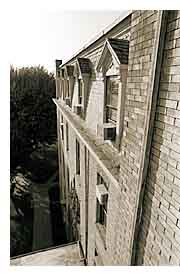 The
original building was built to impress. The bare 1892 landscape made the cupola
easily visible from downtown Walla Walla. It featured a main building and
two rear wings, North Hall and South Hall. Thanks to the donations and wishes
of Dr. N.G. Blalock and the Citizen’s Committee of Walla Walla, it was a large,
impressive building finished with a brick veneer, intricate woodwork, and
attention to decorative detail.
The
original building was built to impress. The bare 1892 landscape made the cupola
easily visible from downtown Walla Walla. It featured a main building and
two rear wings, North Hall and South Hall. Thanks to the donations and wishes
of Dr. N.G. Blalock and the Citizen’s Committee of Walla Walla, it was a large,
impressive building finished with a brick veneer, intricate woodwork, and
attention to decorative detail.
As is the norm, the Ad Building’s “middle age” marked a time of change. The building's new defined roll became almost solely administrative as other buildings were erected around the structure, providing alternate locations for both classes and living accommodations.
After undergoing many renovations and additions, the Ad Building has becomethe familiar structure that we see today. Now as the hallways grow quieter, stilling to silence in the wake of a new vision, the legacy of the grand structure will live on in the memories of those who hold the Ad Building close to their hearts.
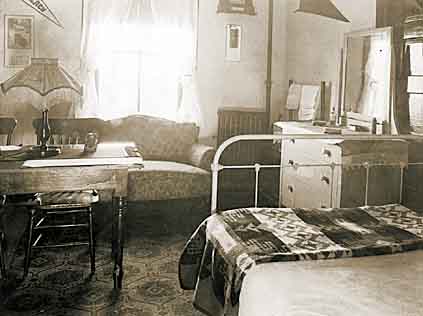
Where They Lived When it was first built, the men and women of WWC lived in the north and south wings of the current Administration Building. This picture, simply identified as “Franks’ Room,” shows the interior of an early college dorm in North Hall, the men’s residence.
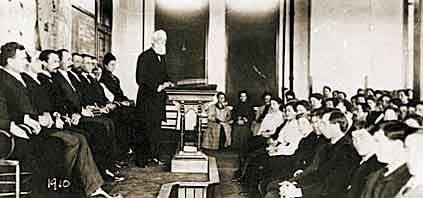
Where They Worshipped The chapel located on the third floor of the Administration Building, was a center for social and spiritual growth. Here J.N. Loughborough, early Adventist pioneer, addresses chapel during the 1910 school year.
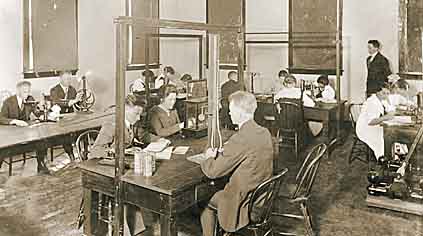
Where They Studied In formal attire, de rigour at the turn of the century, students attended labs in the basement of the building.

One Quiet Moment A rare moment of quiet not typical of the Ad building front entrance, a student looks at a letter.
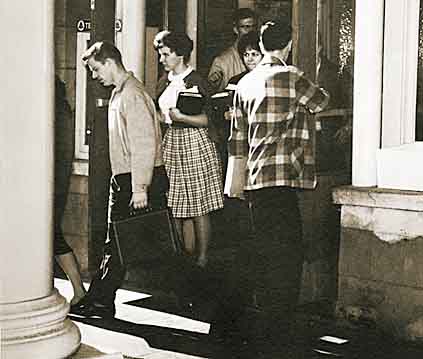
Traffic Jam As enrollment grew, the Ad building’s front door was the epitome of the hustle and bustle of the growing student enrollment in the early 1960s.
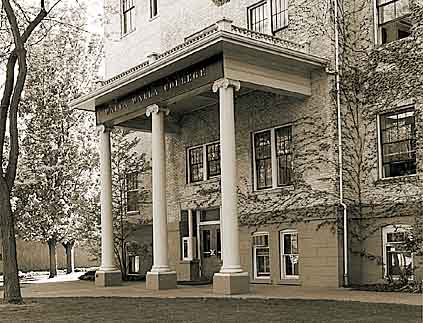
Current Splendor Today the Ad Building hails not only as a physical structure of grandeur and beauty but also as a place held dear in many people’s hearts.
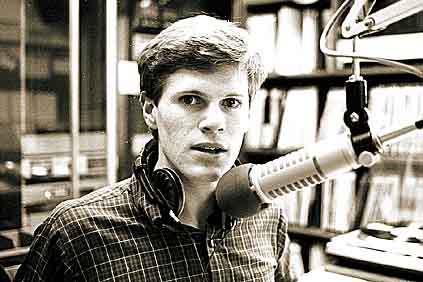
On My Radio In one of the Ad building’s almost hidden corners, KGTS announcer have been beaming Walla Walla College to the region since the early 60s.
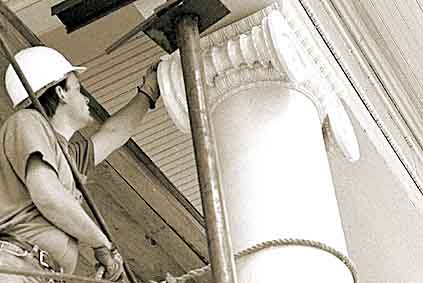
Shiny And New In a tribute to the past, the Class of 1990 revives the pillar the tradition by replacing the boxed pillar crowns with replicas of the original crowns once topping the pillars of the first Ad building.
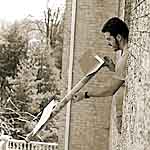 |
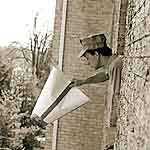 |
Egg drop At least once a year since the early 70s, the School of Engineer’s Egg Drop turns all eyes to its upper windows.